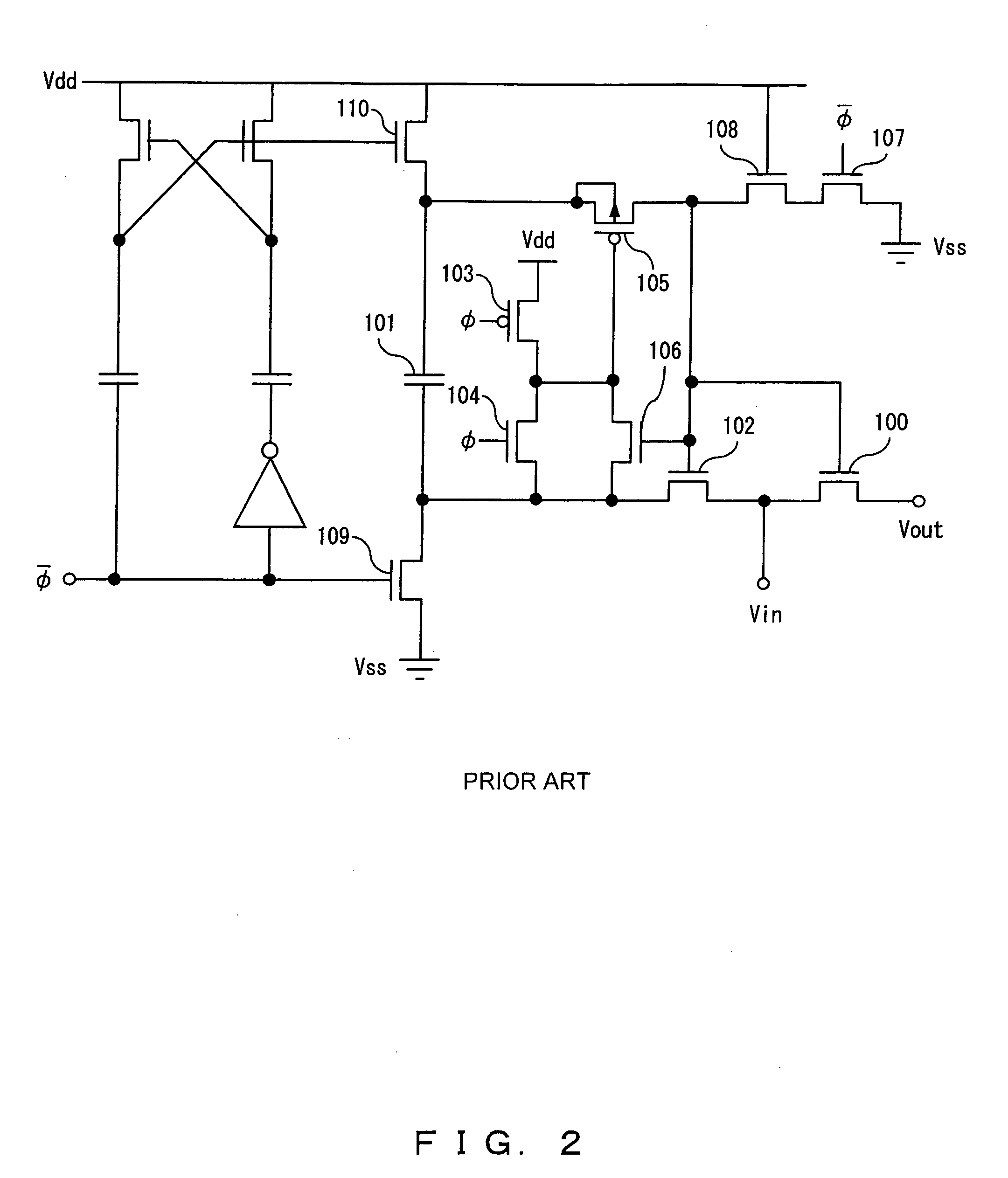Sampling switch
a sampling switch and switch technology, applied in the field of sampling switches, can solve the problems of large distortion added to the signal, the voltage at the source terminal and the drain terminal cannot be considered to change in the same fashion when the input signal changes in high speed, and the conversion characteristics of the a/d converter will be impaired, so as to improve the accuracy of analog signal processing and reduce the distortion of the signal
- Summary
- Abstract
- Description
- Claims
- Application Information
AI Technical Summary
Benefits of technology
Problems solved by technology
Method used
Image
Examples
first embodiment
[0048]FIG. 5 shows a basic circuit configuration of a sampling switch according to the present invention. In FIG. 5, the sampling switch comprises a MOS transistor 10 for being applied by an input voltage Vin to the source terminal thereof and outputting an output voltage Vout from the drain terminal thereof, a supply source 11, capacitances 12 and 13, and switches 14, 15 and 16. These elements except for the MOS transistor 10 constitute a gate voltage control unit noted in claims of the present invention.
[0049]The first embodiment is an embodiment enabling a control circuit comprising a bootstrap circuit for controlling a gate terminal voltage of the MOS transistor 10 to control a delay time of the gate terminal voltage relative to an input voltage Vin in accordance with a delay time of the output voltage Vout relative to the input voltage Vin.
[0050]In FIG. 5, when the input voltage Vin is applied to the source terminal, the MOS transistor 10 is not in conduction, i.e., turned off,...
second embodiment
[0055]In the second embodiment shown by FIG. 6, a voltage between the substrate and source is maintained constant at approximately zero volt by the switch 14 actually connecting the substrate and source terminals of the MOS transistor 10. This enables the voltage between the substrate and source to be maintained approximately constant, in addition to the voltage between the gate and source and that across the gate and drain in the state of the sampling switch being in conduction, thereby further decreasing a change in the on-resistance of the transistor and therefore a distortion of signals induced by the sampling switch.
[0056]While the same effect is gained for the gate terminal voltage control of the MOS transistor 10 as the first embodiment shown by FIG. 5, a capacitance value of the capacitance 13 must be controlled at a smaller value in comprehension of a parasitic capacitance of the substrate terminal since the substrate terminal of the transistor 10 is connected to the node A...
third embodiment
[0079]In the third embodiment shown by FIG. 13, the transistor 35 corresponds to the terminal “b” of the switch 17, the transistor 36 corresponds to the terminal “a” thereof, and the capacitance 37 corresponds to the capacitance 18, each corresponded element respectively shown by FIG. 7. By this configuration, during a time of the transistor 10 being turned off, the transistor 35 is turned on and the substrates of transistors 10 and 35 are both at the ground potential Vss.
[0080]Contrarily, during a time of the transistor 10 being turned on, the transistor 35 is turned on, and the transistor 10 is applied, as the substrate terminal voltage thereof, by an input voltage Vin with a delay time according to a time constant determined by the on-resistance of the transistor 35 and the capacitance of node-C, i.e., the sum of the parasitic capacitance of the node-C and the capacitance of the capacitance 37.
[0081]FIG. 14 shows an example of a sample hold circuit as an exemplified embodiment of...
PUM
 Login to View More
Login to View More Abstract
Description
Claims
Application Information
 Login to View More
Login to View More - R&D
- Intellectual Property
- Life Sciences
- Materials
- Tech Scout
- Unparalleled Data Quality
- Higher Quality Content
- 60% Fewer Hallucinations
Browse by: Latest US Patents, China's latest patents, Technical Efficacy Thesaurus, Application Domain, Technology Topic, Popular Technical Reports.
© 2025 PatSnap. All rights reserved.Legal|Privacy policy|Modern Slavery Act Transparency Statement|Sitemap|About US| Contact US: help@patsnap.com



